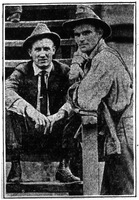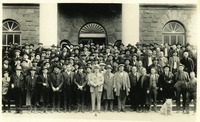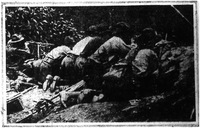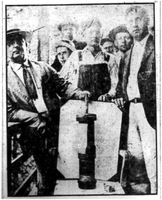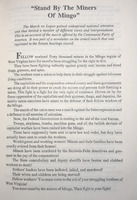The Battle of Blair Mountain
Shootouts in Earnest
The night before the battle began, on August 27th, Captain J.R. Brockus of the State Police led a small squad of men from Mingo County to Boone County, with warrants for forty men provided by Don Chafin. As Brockus and his men searched Beech Creek, they encountered several organized, armed patrols of miners, which they commanded to surrender.
Two of these patrols complied with this order; the third did not, firing upon Brockus and his men. In the skirmish that followed, three men were killed (Logan District, 1921, p. 12-13).
Shots Ring Out Among the Coalfields
Reports conflict as to who fired first, but eventually, violence broke out between marching miners and government officers. On one side, Don Chafin and his state police opposed the marching miners. On the miners' side, it was Bill "General" Blizzard, a prominent organizer who led the miners' army.
According to reports, Bill Blizzard was so skilled in the coordination of his troops that in less than 36 hours after the fighting broke out, his entire army had amassed along the headwaters of the Little Coal River, preparing to march into Logan County (Lee, 1969).
The fighting that broke out was heavily reported upon. Dr. Milliken, a company doctor at Blair mining camp, said that the fighting "was sharp at times. I was in the Spanish-American War, and I heard about as much shooting on Blair Mountain as I heard in Manila" (Lee, 1969, p. 101). The combined fire of sweeping machine gun volleys and coordinated sharpshooters created something similar to a "No Man's Land" (Logan District, 14).
Pictured below is a scene of Logan County Deputies repulsing an attack by the miners.
"A Phase of Civil War"
During this time, war maps appeared in Charleston shop windows, showing Spruce ForkRidge on the border of Logan County as the battle line held by Don Chafin and his multiple heavy armaments. These armaments included two planes, one of which he used to drop bombs on the miners (Corbin, 1997).
The miners received support from many organizations, including the Communist Party of America (Corbin, 1997). Below is a segment of an account of the march offered by the Party.
In a 1921 story printed in The Nation, Heber Blankenhorn calls the conflicts a "phase of civil war that has lasted since 1919" (Corbin, 1997, p. 110). In article by Boyden Sparkes, a prominent war correspondent at the time, Bill Blizzard is described as a "king in Boone County," with a firing line extending the full length of the Logan-Boone County border (Corbin, 1997, p. 129).
Hostilities eventually ended when federal troops were called in, and the miners obeyed orders to stand down. The federal troops, 1,000 strong and better armed, would have been reinforcing previously-dug trenches and other fortifications. Continuation of the battle would have resulted in massive miner casualties (Lee, 1969). The cost of transporting and maintaining these federal troops came out at roughly a million dollars (Logan District, 1921, p. 5). Adjusted for inflation, that would be equivalent to roughly $14,000,000 today.
